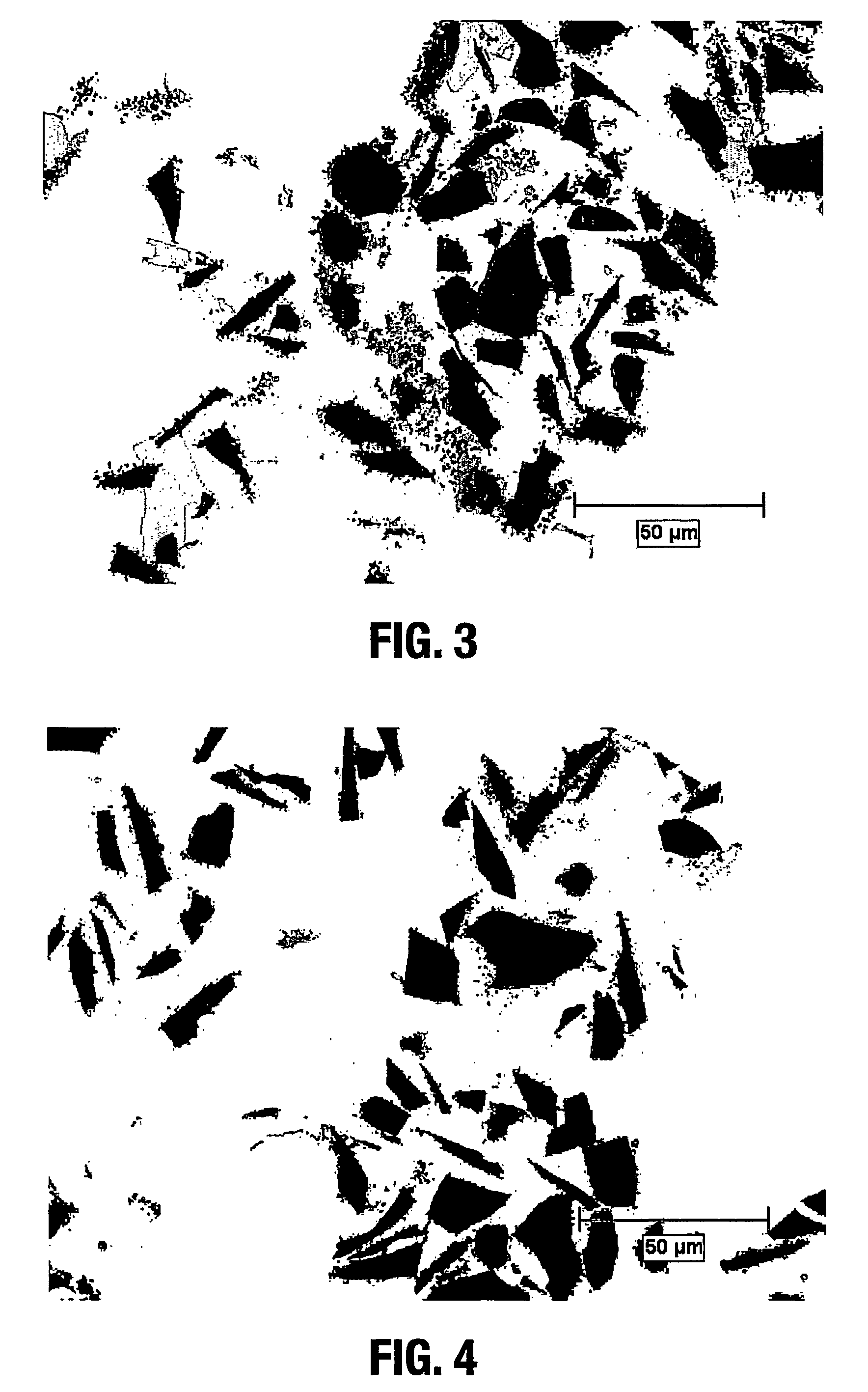Aluminum alloy-boron carbide composite material
a technology of boron carbide and aluminum alloy, which is applied in the direction of greenhouse gas reduction,foundry moulding apparatus, nuclear elements, etc., can solve the problems of reducing the fluidity of the composite material, limited amounts of boron carbide particles could be added to the molten aluminum,
- Summary
- Abstract
- Description
- Claims
- Application Information
AI Technical Summary
Benefits of technology
Problems solved by technology
Method used
Image
Examples
example 1
[0047]Using the technique of U.S. Pat. No. 4,786,467, composites were prepared in which boron carbide particulate was mixed with matrix alloys having the following compositions:
[0048]
TABLE 1Matrix AlloySiFeCuMgZnTiAlloy 1 (wt %)0.540.230.230.91—0.004Alloy 2 (wt %)0.040.630.0850.0040.0060.015
[0049]In the case of Alloy 1 (containing 0.91% Mg), upon addition of only 7.5% by volume of boron carbide, the mixture became highly viscous and could not be stirred further.
[0050]In the case of Alloy 2 (containing only trace amounts of Mg), 15% by volume of boron carbide was added without any stirring problems. This composite material was then held for one hour and was still sufficiently fluid for casting. Samples taken from the cast ingots using Alloy 2 were rolled on a laboratory rolling mill to thickness of between 1.65 and 2.20 mm, and the samples were subjected to neutron absorption tests. An average neutron attenuation coefficient of 1.06 μm / mm was obtained.
example 2
[0051]A further composite was prepared according to the methods outlined in U.S. Pat. No. 4,786,467 in which 15% by volume of boron carbide particulate was combined with an Al-8.7% Si alloy containing only 0.01% Mg by weight.
[0052]This material was held for 1.5 hours and still retained sufficient fluidity to be cast easily. The matrix alloy was similar to alloys disclosed in U.S. 5,186,234 commonly used for manufacture of metal matrix composites using SiC reinforcement, except that the Mg level was again at trace level rather than the normal level of at least 0.3% by weight specified for such alloys.
example 3
[0053]A further set of composites was prepared according the methods in U.S. Pat. No. 4,786,467 in which 15% by volume of boron carbide particulate was added to AA1xxx and AA4xxx base alloy containing various added concentrations of titanium. The fluidity of the resulting mixture after holding the composite for various times was tested by casting the composite into a book mould in the form of an elongated horizontal strip 6 mm thick having spaced restrictions every 36 mm along the strip, where the restriction reduced the thickness to 3 mm at that point. The distance that the composite flowed along the mould before solidifying was a measure of its fluidity. A “fluidity” of greater than 50 mm was considered acceptable.
[0054]In Table 2 fluidity measurements at various holding times are given for a base aluminum alloy containing 0.02 wt % Si, 0.13wt % Fe, 0.003 wt % Cu, 0.002 wt % Mg, 0.001 wt % Mn, 0.002 wt % Zn. The base alloy also contained 0.001 wt % Ti and to this alloy varying amo...
PUM
| Property | Measurement | Unit |
|---|---|---|
| volume percent | aaaaa | aaaaa |
| volume percent | aaaaa | aaaaa |
| volume percent | aaaaa | aaaaa |
Abstract
Description
Claims
Application Information
 Login to View More
Login to View More - R&D
- Intellectual Property
- Life Sciences
- Materials
- Tech Scout
- Unparalleled Data Quality
- Higher Quality Content
- 60% Fewer Hallucinations
Browse by: Latest US Patents, China's latest patents, Technical Efficacy Thesaurus, Application Domain, Technology Topic, Popular Technical Reports.
© 2025 PatSnap. All rights reserved.Legal|Privacy policy|Modern Slavery Act Transparency Statement|Sitemap|About US| Contact US: help@patsnap.com


